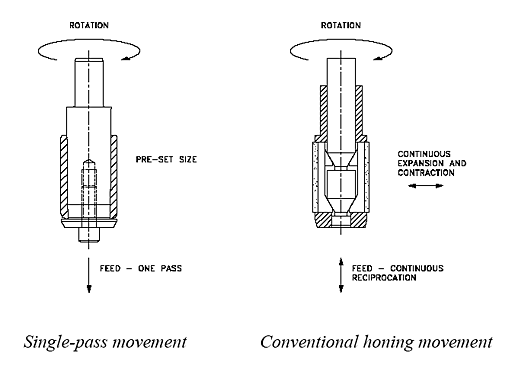|
|
|
| Advancements
in Single-Pass Bore Finishing (continued) |
< Prev Next > |
|
 |
| Process |
The singlepass bore finishing
process involves a series of preset diamond coated tools that get
passed through a bore with a single inandout stroke movement while the
tool, part, or both are rotating. The number of tools that are used
will vary depending upon the amount of stock to be removed, surface
finish requirement, geometrical requirements, and material make up.
Generally each tool is set progressively larger in diameter, in ever
reducing increments, while the size of the diamond particles is also
reduced. This arrangement allows tools with larger diamond particles
that remove relatively large amounts of material, and tools with
smaller diamond particles that have finer surface finish capabilities,
to be used progressively for maximum efficiency.
Sample Multi-Tool Arrangement |
 |
 |
 |
| The singlepass process is in
contrast to conventional honing were the tool or part is reciprocated
many times; while the abrasive portion of the tool is gradually
expanded, then contracted during each cycle. Another difference is in
the abrasive bond of the tool. With the singlepass process, a single
layer of diamonds is permanently plated onto the tool with
approximately 50% of each diamond particle protruding from the bond.
The benefits of this are twofold: greater diamond exposure allows for
faster cutting/stock removal rates, and because the only wear that
occurs on the plated tool come from the diamonds, tool size can be held
for extremely long periods of time without adjustment. Conventional
honing tools normally utilize stones that have abrasive particles
scattered throughout a specific depth in the bond. This type of tool
requires the bond to wear so that new abrasive particles can be
exposed, and provide a much smaller amount of chip clearance. |
 |
 |
| |
|
| |
| < Prev Next > |
| |
| |
|